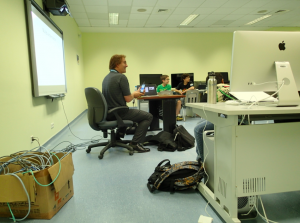My book, “CUDA Application Design and Development” [English][Chinese] and Doctor Dobbs tutorials coupled with the rapid adoption of GPU computing have given me the opportunity to speak and teach around the world. This January, I had the pleasure of traveling to Jeddah, Saudi Arabia to speak and teach a short course on OpenACC and CUDA at KAUST (the King Abdullah University of Science and Technology). While the students at KAUST were excellent, I also had the very rewarding (and initially quite nerve-racking) chance to introduce massively parallel computing to the grade 6 – 12 students at the KAUST International School.
To get the ideas across to such young students, I used C-3PO from Star Wars as a vision of machine-learning in the far distant future. If you remember, the young Darth Vader didn’t have many friends so he rebuilt the walking, talking, human cyborg relations robot using junk parts.
C-3PO is a very popular Star Wars figure, so he provided a natural way to introduce the idea pioneered by Terry Sejnowski and Charles Rosenberg in the 1980s that a neural network can “learn” to read aloud.
I actually use an audio except from their NETtalk demonstration to show how the machine learning algorithm changes from prattling nonsense to correctly reading the English text in a training set.
nonsense:
At found solution:
At this point it is easy to point out that the machine-learning algorithm correctly pronounces words it has not seen before, meaning that the computer has “learned” a general solution to the very complex problem of reading English text.
This leads to the machine learning research I performed in the theoretical division at Los Alamos and in my commercial companies. As a follow-up, I then used Google translate as a modern extension of this machine-learning technique where an English phrase gets translated by dictionary lookup to a foreign phrase which is then read aloud. The students loved hearing my cellphone read aloud various phrases like, “you are wonderful students” in their native tongues.
To finish off, I then used the video framework from my book to show how a Kinect webcam-based game controller can be created.
It was a wonderful experience. As with all my lessons, I try and teach that massively parallel computing technology is so powerful and affordable that even a student working at home or in a dorm room can change the world – much as Linus Torvalds changed the world with Linux.
Happily the teachers later confirmed that the students really did understand my presentation and that they got the message, which is high praise indeed. Look out world, in a few years we may see some game changing innovations coming from these KAUST International School students! (For more information on machine-learning and GPU computing, please see my GTC presentations or on-line tutorials.)


Leave a Reply